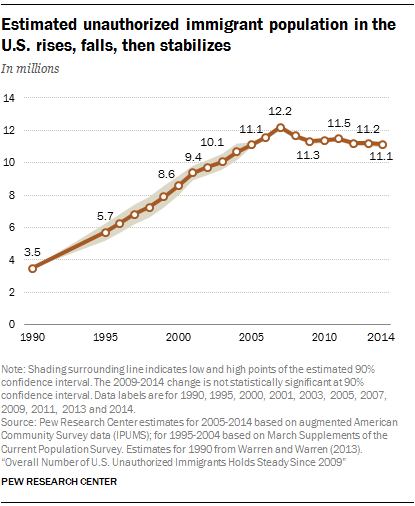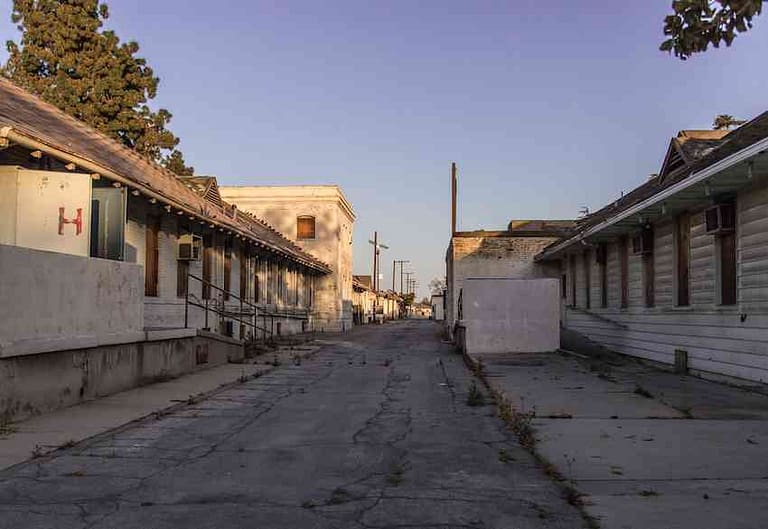9 Myths About Immigration (And Why They’re Wrong)
While it may not seem to fall under the purview of “travel blogging”, you can look at immigration as a very permanent form of travel.
Also, it is impossible to travel the world today and not be aware of the vast migrations of people happening in an increasingly connected and globalized world. After traveling to so many different countries, hearing about so many peoples’ obstacles, issues, and possible motivations for leaving their home, while also being from an immigrant family myself, immigration is an issue that is very important to me.
Disclaimer: Lose the Map contains affiliate links and is a member of Amazon Services LLC Associates Program. If you make a purchase through an affiliate link, I receive a small commission at no extra cost to you.
With an upcoming election day, not to mention a lot of inflammatory rhetoric and incorrect information being thrown around about the subject of immigration, I thought some fact checks might be in order.
I personally love myth-busting and dispelling all kinds of incorrect assumptions. That being said, keep in mind that the following list is simply…facts.
It’s not telling you to support one point of view or another on immigration. I will voice my own opinion at the very end, but all the corrections before that use reliable data, statistics, and other information, for which I will include links. No real debate can happen if people disagree on the facts, so this is simply an attempt to remedy that problem.
MYTH #1: Immigrants Are More Likely to Be Violent/Criminals
Correction: Immigrants Are LESS Likely to Be Violent/Criminals
A lot of the fear surrounding the issue of immigration is a result of this widespread myth that immigrant groups, especially undocumented immigrants, include a significant amount of violent criminals.
Reports of crime rates and conviction data indicate that all immigrants, including undocumented immigrants, commit crimes such as homicide, sexual assault, and larceny, at a lower rate than native-born Americans. If you don’t want to read the whole Cato Institute report, I’ll include the concluding paragraph below:
“The homicide conviction rate for illegal immigrants was 16 percent below that of native-born Americans in Texas in 2015. The conviction rates for illegal immigrants were 7.9 percent and 77 percent below that of native-born Americans for sex crimes and larceny, respectively. For all criminal convictions in Texas in 2015, illegal immigrants had a criminal conviction rate 50 percent below that of native-born Americans. Legal immigrants had a criminal conviction rate 66 percent below that of native-born Americans.” – Cato Institute
Relatively high detention rates for undocumented immigrants are often misleading because many people assume this indicates a higher rate of violent crime among that group. However, most of the undocumented immigrants in detention are there simply for the crime of illegally crossing the border, not for any crime committed against a US-born person or person’s property.
MYTH #2: The US Is in the Midst of an Immigration Crisis
Correction: Border Arrests and Incoming Undocumented Immigrants Have Dropped to Historic Lows
US Customs & Border Protection has recorded a rapidly decreasing number of apprehensions at the border over the past two decades. Apprehensions at the US-Mexico bordered totaled 1.64 million in 2000; they totaled only 303,916 in 2017. This is a HUGE drop that has been going on for years. In fact, most undocumented immigrants (75%) living in the US now have been here for over 10 years. This is also obvious in the stabilization of the undocumented immigration population recorded by the Pew Research Center.

Since Mexicans make up the largest portion of undocumented immigrants, improving economic conditions in Mexico (despite the drug violence plaguing select regions of the country), lower birth rates, and the effects of the Great Recession in the US lured many Mexicans back over the border. There IS increased immigration from Central America, especially Guatemala, Honduras, and El Salvador, but it has not come close to making up for the number of undocumented Mexican immigrants leaving the US.
MYTH #3: Immigrants Coming to the Border Messed Up Their Countries, They Should Stay and Fix Them
Correction: The US Has Played a Very Large Part in Destabilizing Governments, Fueling Violence, and Worsening Conditions in Central American Countries
This is one I, unfortunately, hear a lot. It is very simplistic, harsh, and mostly incorrect, to put the blame for corrupt governments and drug violence squarely on the shoulder of Central American citizens. The fact is, a significant chunk of drug violence has been fueled by the very high demand of US citizens for illegal drugs, especially cocaine, as well as the failing War on Drugs which has made cartel activities obscenely profitable, and drug trafficking work a lucrative draw. Former Homeland Security Secretary John Kelly stated in The Miami Herald, “There are some in officialdom who argue that not 100 percent of the violence today is due to the drug flow to the U.S., and I agree, but I would say that perhaps 80 percent of it is”.
Here are some other quick facts about US interference in regional democracy:
Guatemala:
- CIA overthrows the democratic government of Guatemala in 1954 because the passage of labor laws to improve working conditions threatened US corporate interests
- The US replaces democracy with a military coup, helps train oppressive Guatemalan military for decades to fuel 36-year long civil war which kills 200,000 Guatemalan citizens
Nicaragua:
- US funds and helps train the Contras in Nicaragua, right-wing rebel groups that committed repeated terrorist attacks and inflicted human rights violations throughout the region, from the 1970s to 1990s
- Documents obtained through leaks have shown that up until the present day, the US continues to fund efforts to undermine the democratically elected president Daniel Ortega, support his opponents, and discourage voters. However, Ortega has succeeded despite US interests opposing him, because of several programs he has introduced that have reduced poverty and raised incomes for the Nicaraguan people. However, the US still opposes him because they don’t feel he is doing enough for US businesses.
- I should note here that, perhaps thanks to Ortega’s pro-people policies, rather than pro-foreign business interest policies, there are WAY fewer Nicaraguans coming to the US border than citizens of neighboring countries. This is one indication that US-backed authoritarian governments in Central America directly lead to higher emigration from their countries.
El Salvador:
- US opposes free elections in El Salvador in 1960, facilitates right-wing coup instead
- 1980-1992: US assists the authoritarian government and trains its military to quash dissent and resistance groups, fueling a civil war resulting in the deaths of around 80,000 Salvadoreans.
- At the same time, in 1984 for instance, the US only accepted 3% of claims by Salvadorean asylum seeks, contesting their (true) assertions that El Salvador was experiencing massive human rights violations because it couldn’t admit a US-supported government was causing such devastation.
- Those who entered the US in the 90s and got protected status are now being threatened with a reversal of that status and deportation, even though El Salvador continues to be the most violent country in the world, and warlike conditions persist on the streets.
US-Led Economic Involvement in the Region
- After instituting many of its authoritarian allies in government leadership positions, the US passes a trade deal known as CAFTA-DR, the Dominican Republic-Central American Free Trade Agreement. This creates massive trade deficits that favor the US, and Central American countries have to accept (mostly subsidized) agricultural US imports duty-free, undermining their own industries.
- As a result of CAFTA, many Central Americans are pushed off family farms and into cities that have job shortages. Though GDP has grown, inequality has worsened and many working-class Central Americans are worse off than before.
- As stated before, thanks to large US demand for illegal drugs, cocaine especially, and the general lucrative rewards of the drug trade, partly a result of the costly US War on Drugs, Central America’s problem of gang and drug violence has intensified severely.
MYTH #4: Immigrants Take Jobs from Americans
Correction: Studies Show Immigrants Create Many Jobs in the USA, Due to Higher Productivity, Entrepreneurship, and Scientific/Technological Breakthroughs
Non-partisan research done into the issue of whether immigrants take jobs away from US-born citizens has frequently shown this not to be the case. In fact, according to many papers, including this economic analysis by UC Davis, immigrants increased productivity. “First, we confirm that there is no evidence that immigrants crowd out employment of (or hours worked by) natives. Second, we find that immigration is significantly associated with total factor productivity growth.”
In addition to these findings, immigrants are disproportionately represented among innovators, scientists, and entrepreneurs, building companies that create many jobs for Americans. Here are some quick stats:
-
- 51% of the US’ “unicorns”, aka $1 billion and over startups, have at least one immigrant founder
- 43% of Forbes 500 companies were founded by immigrants or their children. According to the Brookings Institution, the Forbes 500 companies produced $5.3 trillion in revenue and employed 12.1 million workers. So remember, 43% of that revenue and employment is thanks to immigrants.
- Though immigrants are only 14% of the population, they account for 27.1% of entrepreneurs in the US.
- “Immigrants are far more likely than natives to study science and engineering and more likely to produce innovations in the form of patents”, as found by Gordon Hanson of UC San Diego
Surrounded by both an immigrant family and many immigrant friends, these disparities actually make a lot of sense to me. It has nothing to do with one ethnicity or culture outperforming another; rather, immigrants tend to be a self-selecting group of driven, ambitious people who want to create a better life. Leaving your home, friends, and family is not something done lightly. Therefore, people willing to take that risk to start a completely new life in a foreign, unknown place, tend to be highly motivated.
MYTH #5: Undocumented Immigrants Don’t Pay Taxes
Correction: Undocumented Immigrants Pay Around $12 Billion (Possibly More) in Taxes
It is hard to estimate the exact amount undocumented immigrants pay into the system, but even the most anti-immigrant sources concede that undocumented immigrants do contribute to the economy.
Stephen Goss, Chief Actuary of the Social Security Administration, told the New York Times that, “undocumented workers contribute about $15 billion a year to Social Security through payroll taxes. They only take out $1 billion” from that fund. Contrary to popular belief, many undocumented immigrants file income taxes, partly because they believe this will eventually help them plead their case for permanent citizenship.
Meanwhile, undocumented workers are not eligible for Medicare or Social Security, meaning for the most part they have no access to most US government benefits.
Also, the Institute on Taxations & Economic Policy found that undocumented immigrants pay almost $12 billion in state and local taxes.
That being said, undocumented immigrants do stress the hospital and education systems of the places in which they reside, but other studies have found that any drain on the system is partly covered by their tax dollars and more than made up for by the time their children become working adults, as this cohort of the population has been found to be one of the most productive groups, economically.
MYTH #6: Undocumented Immigrants Depress Wages for Americans And Hurt the Economy
Correction: The Effect of Undocumented Immigrants on Wages is Complex and Highly Debated, But Almost All Economists Agree the Economy Would Shrink Without Them
Because this is a myth-busting and not simply a pro-immigration article, it is important to note that the effect of immigrants on wages is highly contested and complex. A compilation of 27 studies on the subject showed that most studies concluded immigration had pretty much no effect on wages, while a couple found a positive effect, and a couple found a negative effect.
One study showed that incoming undocumented immigrants HAVE been found to have a small negative effect on the wages of US workers without a high school diploma (about 25 million people, or 7.7% of the US population). The negative effect is anywhere between 0.4% and 7.4% on wages, depending on the study and occupation.
However, for skilled laborers and all other workers, undocumented immigrants positively impact wages and economic growth. A great study by the National Academies of Sciences, Engineering, and Medicine goes into great detail over the different positive and negative effects immigration has on wages and the economy.
Still, a mass deportation would negatively affect a lot of state economies and industries. In 2007, when Arizona pursued a large crackdown and deportation of illegal immigrants, the economy shrank by 2%.
Perhaps the issue is best summarized by an open letter from 1,470 non-partisan economists, both Republicans and Democrats, who said, “the benefits that immigration brings to society far outweigh their costs, and smart immigration policy could better maximize the benefits of immigration while reducing the costs.”
MYTH #7: All Immigrants Approaching the Border Are Trying to Enter Illegally
Correction: Many Immigrants Approaching the Border Apply for Asylum Upon Entering the US
I’ve heard this myth circulating quite a lot lately, especially with the “migrant caravan” from Central America regularly featured in the news cycle recently. Some pundits and viewers speak about this caravan as though the migrants in it are trying to rush the border all at once and illegally enter the US.
The fact is, many migrants in those caravans, along with many other migrants approaching the US-Mexico border, are coming up to apply for asylum. Many of them will not get it, but in fact, it is quite common for migrants at the border to have peaceful interactions with US Border Patrol and apply for asylum.
Also, this is not the first time a “migrant caravan” has happened. Migrants from dangerous Central American countries tend to band together to get the protection of large numbers and have some insurance against the violence and harsh conditions they expect to encounter on the road. This one just happens to be a large group, and has the attention of the President.
Myth #8: Other Undocumented Immigrants CHOOSE To Come Here Illegally
Correction: Most Undocumented Immigrants Have No Real Option Within the US Immigration System to Come Here Legally; the System Has Become Prohibitively Exclusive for Most Compared to 100 or Even 50 Years Ago
The US gives three options, besides winning a lottery (only available to citizens of countries with low immigration rates to the US) or marrying a US citizen, for immigrants to enter the country legally.
Or, as even the fiscally conservative publication The Economist put it, “there is almost no way for low-skilled Mexicans who lack American relatives to migrate north legally”.
Family-based immigration
This necessitates that a) you already have immediate family living in the US b) your family member’s income is considered high enough for them to take responsibility for supporting you. Many aspiring immigrants have no family in the US, and even those that do can face several-decade-long wait times. Children of US citizens that live outside the country must wait five years for a visa, while siblings must wait for around ten years. Immigrants from countries like Mexico face wait times of over 20 years. For those fleeing violence, or who have pressing life-or-death economic needs, this is obviously not an option, even if you are lucky enough to have an immediate family member in the US.
You may have heard of the dangers of “chain migration”, but the truth is, someone can’t come and bring in 22 distant relatives. Only immediate relatives are accepted, and that’s usually after a couple of decades of waiting.
A US employer requests a specific worker
This is usually applied to very high-skilled positions, necessitates that the employer can’t find a US citizen to do the required job, and then necessitates that the employer must sponsor the employee. Unless you are a top-level executive or hold a Ph.D., this is unlikely to be an option available to you. In my personal experience with friends from other countries gaining doctorates from top-level US universities, even highly-skilled immigrants who paid tens of thousands of dollars to US universities to get educated have a lot of trouble getting this visa.
Humanitarian protection
Most immigrants fleeing violence in Central America use this method, but the US has a cap on how many immigrants it can accept for reasons of humanitarian protection. Several agencies run checks on the applicant for asylum, and if the applicant cannot prove beyond a reasonable doubt that they have a “well-founded fear of persecution based on race, religion, membership in a particular social group, political opinion, or national origin”, they are denied.
There are a few more exceptions when it comes to legal immigration, but again, most of it favors the very rich or a select few. Notable artists and sports figures can apply for an O1 Visa, and those seeking to get an investment visa need to have a bare minimum of $150,000 to invest, with a better visa requiring $500,000 to secure. Other than that, the default option for most who have a pressing need to move becomes illegal immigration.
MYTH #9: My Ancestors Came Here Legally, Immigrants Now Should Be Able to Do the Same Thing
Correction: There was no such thing as “illegal” immigration for a lot of US history, and even after that, immigration laws were very lax for most of the 20th century
ANY immigrant entering the US before 1882 was legal. There was no real process for entering the country other than getting on a mode of transportation and then getting off the boat.
The first general immigration law was passed in 1882, in addition to the Chinese Exclusion Act, but even that law had very few requirements. According to Kevin Jennings, President of the Tenement Museum, “If you were an able-bodied, non-Chinese person, you could come “legally” for several more decades” after 1882. No English skills were required, and literacy (in any language) was only introduced as a requirement in 1917.
The concept of needing specific papers, or visas, was not even introduced to the US government until 1924.
So the conclusion is that almost all current US citizens who claim their ancestors came here “legally” three or more generations ago are actually incorrect. And the fact remains that, under today’s very strict immigration policies, almost none of your ancestors would probably have been allowed into the US in teh first place.
CONCLUSIONS?
Here is where I will add my personal opinion. The issue of immigration is a complex one, for obvious reasons. It has been proven beyond a reasonable doubt that legal immigrants are some of the hardest-working, most law-abiding citizens in the US, and their work leads to job creation as well as huge technological leaps forward for the US economy.
Undocumented immigrants can have an effect on low-skilled workers’ wages, and do use US services like hospitals, but they also lead to overall economic growth, pay a lot of taxes and are not entitled to most US benefit programs. It is also important to note that, contrary to popular belief, there are usually no good legal pathways available for those immigrants to enter the US, because legal immigration has gotten infinitely harder now than back when many US citizens’ ancestors entered the US.
In my view, creating an attainable legal pathway for unskilled immigrants and THEN cracking down on remaining illegal immigration, thereby ensuring immigrants receive similar pay to native-born workers and can unionize in the same way, would go a long way towards taking care of the problem of potentially depressed wages and other economic drains. However, the net benefit of immigration, even undocumented immigration, STILL seems much higher than the cost, and it has been proven that states initiating mass deportations see their economies shrink.
Most of all, it is important to note that even though immigration, especially undocumented immigration, may be one of the most hot-button issues of the day, immigration’s role in the national discourse seems outsized compared to its actual extent.
The number of undocumented immigrants in the US has been declining or stable in the past decade, depending on the year, and there are fewer undocumented immigrants approaching our southern border today than there ever have been in the past 50 years. And it has been proven that those immigrants are, for the most part, less likely to commit felonies than the native-born population, and simply here looking for work or fleeing violence that the US has helped create, and continues to forment.
So in addition to everything else, now we have to approach the issue of perhaps accepting more asylum applicants as well. Because since the US has played a large role in destabilizing these countries and helping create the rise of drug-related violence, there should be an element of ethical concern with helping “clean up our mess”, so to speak.
These are my personal viewpoints, and you can disagree. But the above stated facts and corrections are worth considering, as it is also worth considering that immigration is a complex problem with many facets, and decisions like initiating mass deportations or making legal immigration even more difficult can have serious unintended, negative effects, you may have not considered.








Malcolm Gladwell did an episode of Revisionist History that explored how the US actually created the undocumented immigration problem on the southern border in the 1970s. The episode is called General Chapman’s Last Stand. It’s another piece of the broader picture of our immigration history.
Interesting! I love Gladwell’s work overall, I will definitely be checking that out. Thanks for the recommendation!
This article provides a thorough and informative overview of some of the most common myths and misconceptions surrounding immigration. By debunking these myths and providing factual evidence to support their claims, the authors help to dispel some of the fear and misinformation that often surrounds this topic. It’s important for people to have a clear understanding of the realities of immigration, especially as it continues to be a highly debated and politically charged issue. This article is a valuable resource for anyone seeking to gain a better understanding of the complex issues surrounding immigration. https://qna.habr.com/user/BabarAzam
This is a very informative post, Joanna. I couldn’t agree more, immigration is indeed a complex problem. Let’s stick with the facts :)
Jessica recently posted…Best Meat Slicer for Making Jerky : Reviews
Completely agreed!
You are absolutely right that not all immigrants come illegally and there many reasons why an immigrant comes, a very thoughtful post Joanna, thanks for sharing.
Thank you!
It’s good to know that you’ve been trying to dispel all kinds of incorrect assumptions about immigration. I’ve met a lot of online friends who don’t want to migrate here since they’re not sure about the process and the culture. I think that consulting a lawyer who can represent them and their transfer would help.
http://www.immigrationlawcenterinc.com/immigration-law/
You are completely correct that not all immigrants enter the country illegally, and there are various reasons. Also yes immigration is indeed a complex problem. Thanks for sharing this thoughtful piece, Joanna.
https://www.slideserve.com/emmawarner96
Thanks for sharing useful information. We’ll move this up into the post.https://www.legacytree.com/blog/family-reunion-activities